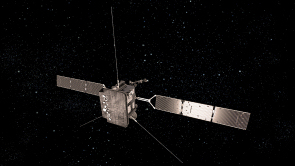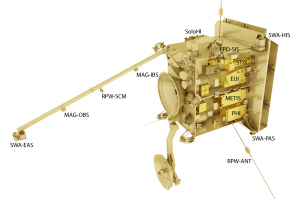Spacecraft
The Solar Orbiter spacecraft is a Sun-pointed, 3-axis stabilised platform with a dedicated heat shield to provide protection from the high levels of solar flux near perihelion.
 |
| Artist's impression of Solar Orbiter. Credit: ESA |
The spacecraft provides a stable platform to accommodate the combination of remote-sensing and in situ instrumentation in an electromagnetically clean environment. The 21 sensors were configured on the spacecraft to allow each to conduct its in situ or remote sensing experiments with both access to and protection from the solar environment.
With a view to keeping cost down, whilst still allowing the full operation of the in situ and remote-sensing instruments, Solar Orbiter has inherited technology from previous missions, such as the solar arrays from the BepiColombo Mercury Planetary Orbiter.
The solar arrays can be rotated about their longitudinal axis to avoid overheating when close to the Sun. A battery pack provides supplementary power at other points in the mission such as eclipse periods encountered during planetary flybys.
 |
| Payload accommodation onboard Solar Orbiter. Credit: ESA |
The Telemetry, Tracking and Command Subsystem provides the communication link capability with the Earth in X-band. The subsystem supports simultaneous telemetry, telecommand and ranging. Low-Gain Antennas (LGAs) are used for Launch and Early Orbit Phase (LEOP) and will also be available as a back-up during the mission phase when steerable Medium- and High-Gain Antennas will be in use.
The High-Temperature High-Gain Antenna needs to point to a wide range of positions to achieve a link with the ground station and to be able to downlink sufficient volumes of data. Its design was adapted from the BepiColombo mission.
The antenna must also cope with a high thermal load and be conducting to avoid build-up of electrostatic potential. The antenna can be folded in to gain protection from Solar Orbiter's heat shield if necessary. Due to the mission's unique orbit, the throughput of the data downlink is highly variable. Most data will therefore initially be stored in on-board memory and sent back to Earth at the earliest possible opportunity.
| Spacecraft | 3-axis stabilised platform, heat shield, two adjustable solar arrays, dimensions: 2.5×3.0×2.5 m3 (launch configuration) |
| Orientation | Sun-pointing |
| Telemetry band | Dual X-band |
| Data downlink | 150 kbps (at 1 AU spacecraft-Earth distance) |
| Closest perihelion | 0.28 AU |
| Max. heliographic latitude | 24° (nominal mission) / 33° (extended mission) |
| Launch date | 2020 |
| Nominal mission duration | 7 years (including cruise phase) |
| Extended mission duration | 3 years |
| Post-operations & archiving | 2 years |
| Ground station | Malargüe (Argentina), 35-m antenna, 4 to 8 hours/day (effective) |


